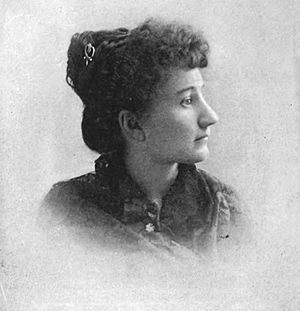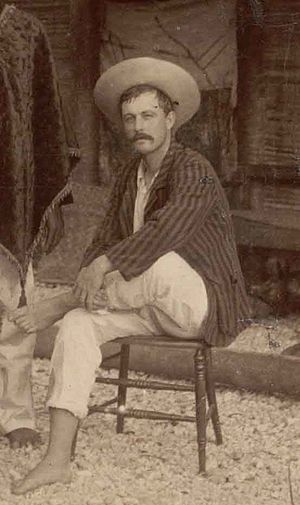Remittance man facts for kids
In British history, a remittance man was an emigrant (someone who moved away from their home country). These people often moved from Britain to a British colony. They were supported by regular payments from their families back home. The idea was that these payments would encourage them to stay away.
This old meaning of "remittance" is different from what it means today. Today, "remittance" usually refers to money that migrants send *back* to their home countries. But for a "remittance man," the money was sent *to* him to keep him away from home.
Contents
What Was a Remittance Man?
A "remittance man" was a term used a long time ago, especially before World War I. It described an immigrant living in places like Canada or Australia. Their families in England would send them money. This was often done to make sure they wouldn't come back home and cause problems or embarrassment.
The Oxford English Dictionary says a remittance man was often someone considered "undesirable" at home. The term first appeared in writing around 1874. It was a common phrase in the colonies.
Who Were Remittance Women?
While most discussions are about men, there were also "remittance women." These women also received money from home to stay away.
For example, Bertha E. Kyte Reynolds lived in a tent in the Rocky Mountains in the early 1900s. Her family sent her money. Another example is Jessie de Prado MacMillan, a Scottish woman who started a farm in New Mexico around 1903.
Ella Higginson, a famous poet from Washington State, wrote about a special "remittance woman." She told a story about a young royal who was supposed to become George V. He allegedly had a secret marriage. When he had to end this marriage, his beloved was sent away. Higginson wrote that this woman lived near Vancouver, Canada, as "the veriest remittance woman." She believed this woman should have been the Princess of Wales.
In 1979, The New Yorker magazine mentioned Lady Blanche Hozier, the mother of Clementine Churchill. Lady Hozier lived in Dieppe, France. She was described as living "the life of a remittance woman." She enjoyed gambling at the casino and hosted small gatherings.
Remittance People in Stories and Films
The idea of a remittance man was very common in books and stories from that time. This was especially true in Britain, Canada, and Australia.
Rudyard Kipling, a famous writer, often wrote about remittance men. He also wrote about "gentleman rankers." These were men from good families who would normally become officers in the army. Instead, they joined as regular soldiers, often because of problems at home. Kipling wrote a sad story called "One Lady at Wairakei" (1891) about a remittance man in New Zealand.
In the 1892 novel The Wrecker by Robert Louis Stevenson, there's a character named Tom Hadden. He was known as Tommy. Tommy was supposed to inherit a lot of money. But his father had put the money in the hands of strict managers. Tommy would spend his yearly income quickly and then live quietly among islands for the rest of the year. This character was based on a real person named Jack Buckland.
Mark Twain, another famous writer, described meeting remittance men in his 1897 travel book, Following the Equator. He wrote that families would send "dissipated ne'er-do-wells" (people who were lazy or caused trouble) abroad. They would get just enough money to travel. Then, a small amount of money would arrive each month. Twain said these men would pay their rent, then spend the rest of their money in one night. After that, they would be sad and bored until the next payment arrived. He called it a "pathetic life."
In 1897, Beatrice Harraden published two novellas, Hilda Stafford and The Remittance Man. In The Remittance Man, the character can only truly grow up when the money from home stops coming.
The Canadian poet Robert W. Service wrote a poem called "The Rhyme of the Remittance Man" in 1907. It talks about being far away from London and Paris, finding peace, and wondering if he should have chased money like his brothers.
William Henry Pope Jarvis wrote a novel in 1908 called The Letters of a Remittance Man to his Mother. It was written as letters from a remittance man to his mom.
The Remittance Woman was a silent film made in 1923. The next year, a book with the same title came out by author Achmed Abdullah.
In the novel Brideshead Revisited, a character named Sebastian Flyte is called a remittance man. The British Consul says about him, "This is no place for a remittance man. The French [authorities] don't understand him at all. They think everyone who's not engaged in trade is a spy."
The Australian poet Judith Wright included a poem called "Remittance Man" in her 1946 book, The Moving Image. It starts by describing a "spendthrift, disinherited and graceless" person who easily accepts his small payment. He is surprised he could escape his old life so simply.
In the 1960s, a character in Stephen Marlowe's books, Andrea Hartshorn, describes her situation. She says, "Robbie is a remittance man. I'm a remittance woman. We're paid a monthly stipend to keep out of the family's hair." A "stipend" is a regular payment.
Prince Yakimov, a character in Olivia Manning's novel The Great Fortune, is always "waiting for his remittance." He lives by borrowing from other people in wartime Bucharest.
In The Bonfire of the Vanities by Tom Wolfe, the term is used for a wealthy Englishman's daughters. They spend their days going to parties in New York City.
Jimmy Buffett, a singer-songwriter, wrote a song called "Remittance Man" for his album Barometer Soup. He got the idea for the song from Mark Twain's description of remittance men in Following the Equator.
See also



